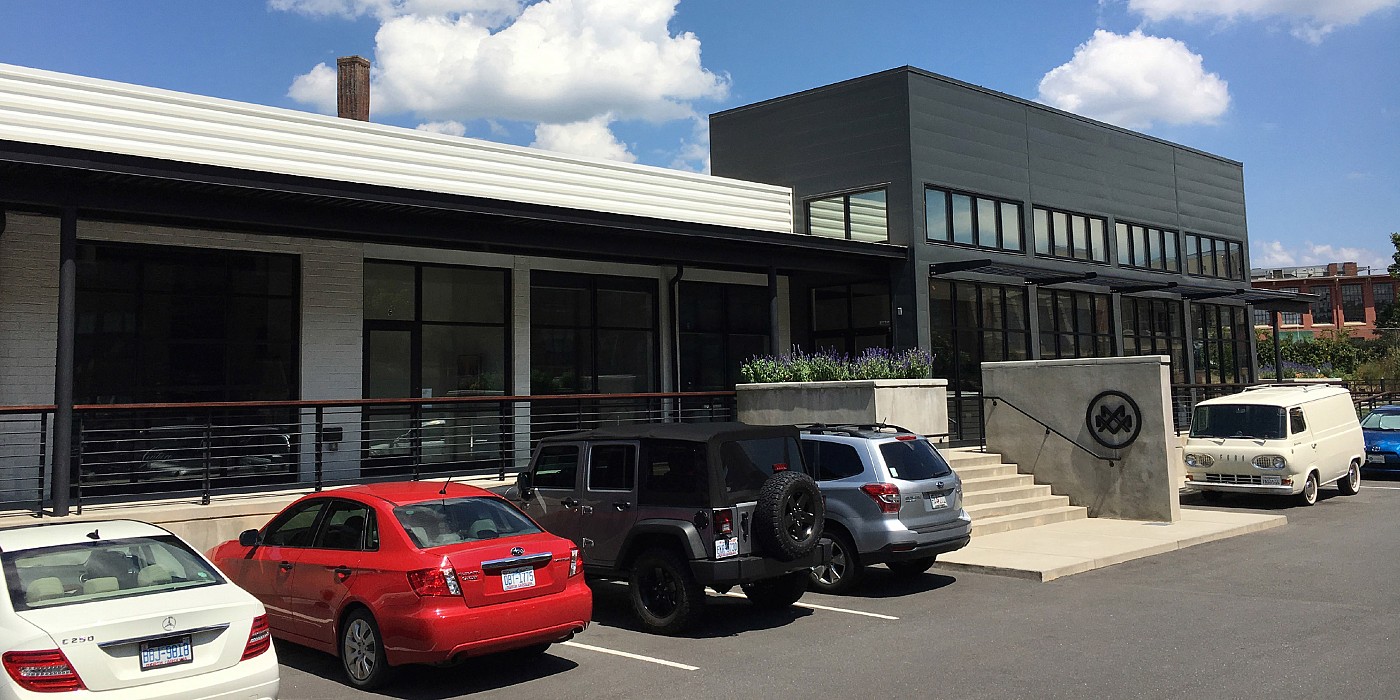- You have not saved any projects.
2173 Hawkins Street
A 22,500 square foot renovation of a former mid-century constructed warehouse building adjacent to the LYNX Blue light rail line in Historic South End, with a mix of office and retail units ranging from 2,500 square feet to 10,500 square feet.







Historic South End, in the shadows of uptown Charlotte, once served as its industrial backbone with cotton mills, steel fabrication, and light manufacturing. It developed over 60 some years and the architecture in this area represented this evolving industrial aesthetic. During its middle period many of the industrial buildings were abandoned but fortunately left in place. The last 25 years have seen an incremental rehabilitation of the area as the nexus for an experiential place rooted in its history and sustainable growth patterns of reuse. Following this initial growth, local restauranteurs and craft brewers started to convert the industrial buildings into venues for food and fun. The approach was to value the existing over the tear down and mega new mentality of the uptown. By retaining at least some portion of the existing structures and architecture of the area, Southend became known as an authentic and holistic place which has been a recent magnate for millennials. With this influx of people, new large scale urban apartment housing has become the dominant development. While many design professionals and other small to mid-size businesses had already moved into the area, it still lacked office space for other types of small startup entrepreneurs and new industry professionals. Many would have looked at this building and its condition as something that would be easier to tear down and start over. But there was a kernel of simplicity to it that acted as a seed for the design idea that followed. With the canvas set and patterns acknowledged, additions and materials were composed to enhance its street presence with glazing and extension of the building both to the street sidewalk and the new Rail Trail.
Built upon the ubiquitous industrial aesthetic of the area while adding layers of new industrial materials and form.
By connecting the two areas with a new covered walkway, pedestrians can now stroll in front of start up businesses while in the shade of the canopy so desirous in the south. The existing industrial dock door openings lent themselves well to the addition of even more glazing along this walkway creating visual interest for the pedestrian and opening up the interior spaces to the activity beyond.
What was seen as a blighted building to walk quickly past has now become a place where folks stroll from their homes to places where they convene with existing and new friends enhanced by this new active urban architectural transformation. Small businesses have moved in with the desire for an enhanced sustainable-scaled growth pattern that in its architecture builds upon pedestrian urban principles while reusing the past in creation of the new. The story of the past resonates through to the present as places such as this building are reimagined and crafted for the future.
Historic South End, in the shadows of uptown Charlotte, once served as its industrial backbone with cotton mills, steel fabrication, and light manufacturing. It developed over 60 some years and the architecture in this area represented this evolving industrial aesthetic. During its middle period many of the industrial buildings were abandoned but fortunately left in place. The last 25 years have seen an incremental rehabilitation of the area as the nexus for an experiential place rooted in its history and sustainable growth patterns of reuse. Following this initial growth, local restauranteurs and craft brewers started to convert the industrial buildings into venues for food and fun. The approach was to value the existing over the tear down and mega new mentality of the uptown. By retaining at least some portion of the existing structures and architecture of the area, Southend became known as an authentic and holistic place which has been a recent magnate for millennials. With this influx of people, new large scale urban apartment housing has become the dominant development. While many design professionals and other small to mid-size businesses had already moved into the area, it still lacked office space for other types of small startup entrepreneurs and new industry professionals. Many would have looked at this building and its condition as something that would be easier to tear down and start over. But there was a kernel of simplicity to it that acted as a seed for the design idea that followed. With the canvas set and patterns acknowledged, additions and materials were composed to enhance its street presence with glazing and extension of the building both to the street sidewalk and the new Rail Trail.
Built upon the ubiquitous industrial aesthetic of the area while adding layers of new industrial materials and form.
By connecting the two areas with a new covered walkway, pedestrians can now stroll in front of start up businesses while in the shade of the canopy so desirous in the south. The existing industrial dock door openings lent themselves well to the addition of even more glazing along this walkway creating visual interest for the pedestrian and opening up the interior spaces to the activity beyond.
What was seen as a blighted building to walk quickly past has now become a place where folks stroll from their homes to places where they convene with existing and new friends enhanced by this new active urban architectural transformation. Small businesses have moved in with the desire for an enhanced sustainable-scaled growth pattern that in its architecture builds upon pedestrian urban principles while reusing the past in creation of the new. The story of the past resonates through to the present as places such as this building are reimagined and crafted for the future.